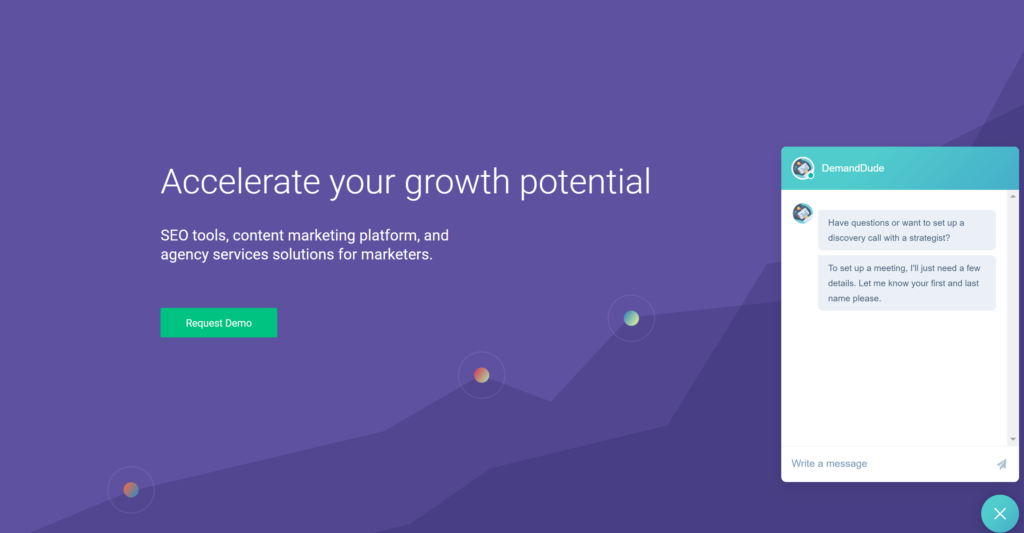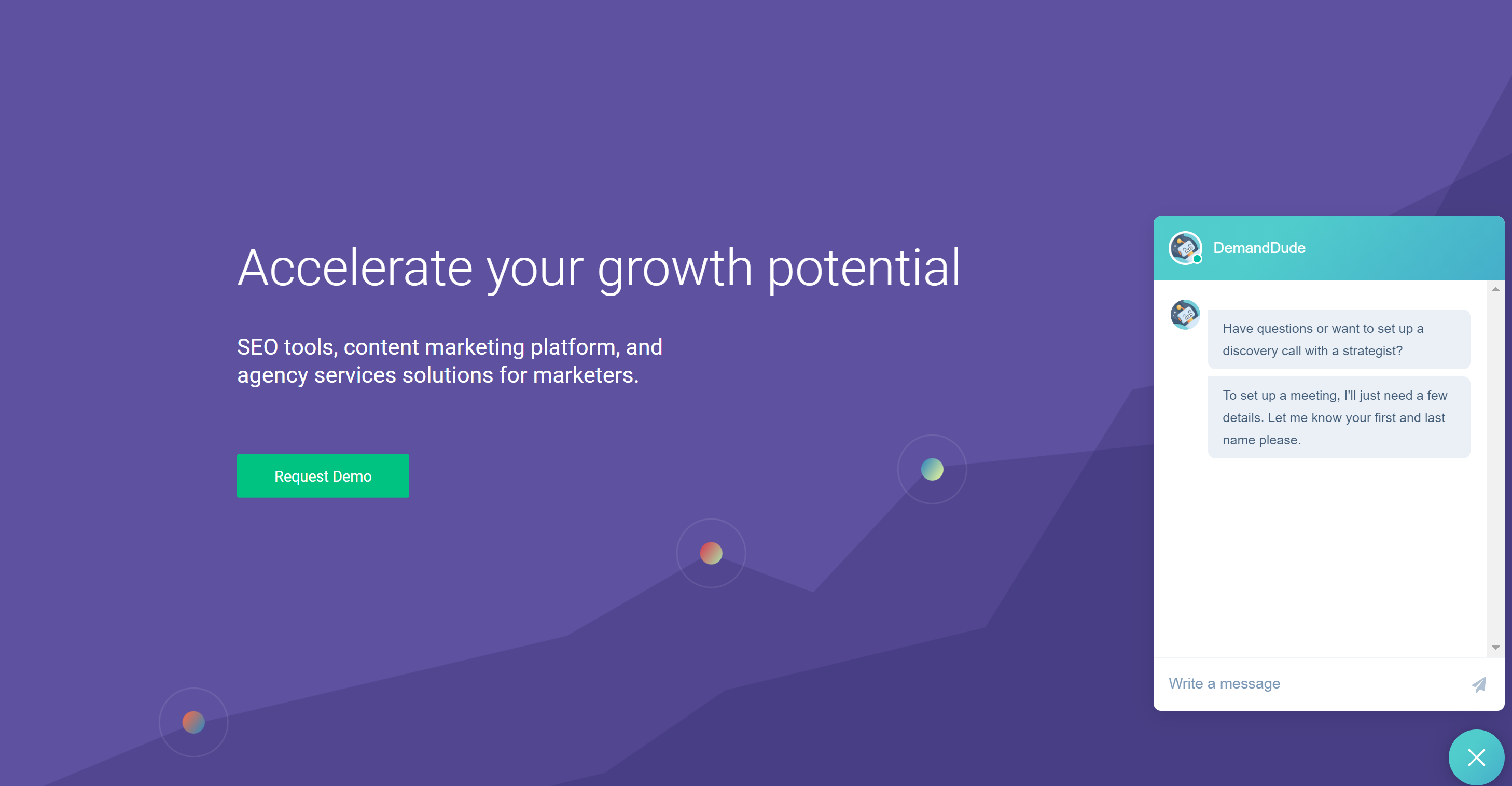On a recent Found Friday, DemandSphere’s Erin Acheson caught up with Jasz Joseph, online marketing strategy manager at SyncShow, to chat about chatbots. SyncShow is an agency focused on manufacturing, transportation, logistics and professional service firms — but chatbots, and the content that populates them, are becoming more popular across industries. Jasz says that many of her clients have had success implementing chatbots in a variety of ways and use cases.
Chatbots are rarely a point of in-depth conversation in the digital marketing space. Many of us think of chatbots in a binary way: turn them on or off, use them or don’t. However, there is an underground strategy that should be used as you consider using a chatbot, and building a strategy behind your bot.
Understand what a chatbot is and what it isn’t.
When we talk about chatbots, and the tactics behind their use, we need to have a definition, and understand the purpose of chatbots in our toolkit. So, what are we talking about when we talk about this service?
- Generally speaking, a chatbot is an automated response service — it is not a live customer service rep. Instead of speaking to a real person, users follow a series of prompts that lead them to an answer or action — which may include speaking to the aforementioned human representative. Often, the purpose of the chatbot is to qualify the user, getting them to the right person before connecting them to live support.
- A chatbot also isn’t an an autoresponder. An autoresponder may show a pop-up saying “click here for more information” or “choose from these options to read more.” A chatbot is more intelligent: it uses information from the user to determine the upcoming course of action.
- Chatbots also aren’t solely for customer service. They have been historically used for lead generation or customer service, but, in the past year or so, we’ve seen them used for all kinds of stuff. Marketers are using chatbots to improve a variety of KPIs, and to assist with lead generation, lead qualification, sales assistance, and, yes, CS. Jasz discussed a recently-built chatbot to decrease bounces on the website of one of her clients. The client’s high-performing blog brought in tons of traffic, but few conversions. By implementing chat, the client’s website asked users directly about their interest in the topics from the blog and pointed them into the direction of a human expert or more information.
Sounds great (and…daunting). Where do we start?
So, where do you start? Jasz says you need to have two things in mind as you consider chat: your objective and your resources.
It’s unlikely that you can create a chatbot that will work for every user and every situation — that’s just too broad of a goal. Instead of trying to do everything at once, have your bot serve a singular, clear purpose. For marketers, an obvious goal may be lead generation. However, just as in Jasz’s bounce rate example, chatbots can serve multiple purposes. Maybe you want to direct more traffic to a high-converting page, or decrease exits on a page you suspect is confusing your customers. Get clear on your purpose, and make sure your team is on the same page.
You also need to consider resources. Does someone need to be available to answer questions the bot can’t handle? Which team will build and maintain the chat service? Who will determine whether the bot is performing well, and what metrics will be used? And, what content will populate your chatbot’s answers? There’s no one-size-fits-all for a chat initiative. Just as is true with so much in digital, options vary from “set-and-forget” versions of chat, as well as more in-depth (and effective) versions. There are also plenty of types of chatbot: while it’s most common to use a third-party service, larger orgs may choose to build their own.
Jasz says opportunity exists if you make the initial investment — in both time and money — of building out a chatbot. A great set-up will be easier to tweak as you learn what your users are looking for through their interactions with the bot.
Consider your existing content.
Think of your resources not only in terms of staffing, but also in terms of content. Do you have enough content to populate an auto-responder, and to answer all of the questions you’ll receive? Will you be able to direct folks to the proper areas of your website: blog posts, web pages, even explanatory videos or long-form pieces? If not, the first step of your initiative may involve building out your content to support your chatbot.
Worried you don’t already have scores of bot-friendly content? That doesn’t mean you can’t use a chatbot: think of this as a way to prioritize content creation. If the bot is intended to serve up high-demand information, that information should be under construction anyway! As with any content creation project, create content in areas where you see major opportunities. Plus, the content you’re creating should have value outside of the chatbot: you should be able to use it as blog material, emails, social posts, and more.
Don’t assume a chatbot can replace a real person.
Users expect a live person on the other side — and they expect that person to be an expert. Mitigate possible customer service issues by setting expectations up-front.
One big misstep taken by some brands: pretending their bot is a human. Users will bring questions that the bot won’t be able to answer; wouldn’t you rather blame that lack of information on a bot than on one of your teammates? Either purposefully introduce the chatbot as a bot (Demandsphere’s greets users with, “hi, I’m DemandDude!”), or, if the bot is unable to answer the question, direct them with language that tells the user they are fetching a live representative. It’s all about matching content to expectations.
If you don’t have the team to support a live chat, a fully-automated responder may be a better choice for your org! If you’re using who are using strictly a chatbot, don’t allow your users to free-type by asking “what can I help you with?” or “what are you looking for?” People will come back with incredibly unique and obscure responses! Give people a set of options, and be upfront in letting users know that they’re talking to a bot.
Be prepared for surprises.
The good news: a chatbot will create amazing opportunities to find out what people need on your website. The weird news: no matter how strong your strategy for content creation, you’ll likely be unable to anticipate 100 percent of your users’ needs. Chatbots are a long-term project, and you can’t necessarily anticipate how your bot will be used. Jasz says that her clients have been incredibly surprised by some of the things users ask their bots, both in breadth and depth of content. If your content is geared toward folks deep in the funnel, you may get questions on the basics of your industry. If your content is geared toward the basics, you may get more advanced-level questioning. You may find that you need to adapt the content served to customers. The opportunities created by refining your chatbot answers may inspire revamping of other areas of your site.

Keep your chatbot content on-brand.
Jasz recommends ensuring that your chatbot stays on-brand by embedding your content team into the chatbot process. The chatbot doesn’t need to sound like a person — but it should sound like it comes from your company (whether that’s formal and professional or fun and spunky). Consider brand colors, brand identifiers, and a name that references your company. Branded elements will help your bot blend in to your website while still standing out on the page. The team that creates your emails, blog posts, and other creative material should also be included in your chatbot content creation process.
As you determine your goals and content. consider your buyer’s journey through that content. How does your chatbot experience compares with the rest of your UX? Match the amount of information shared through chat with the amount of information posted in other areas; don’t create a massive text-block. What content typically results in conversions, and how can you incorporate that content into chat? Where would too much chat feel invasive? Do your users expect a lot of interaction with your site, or will a pop-up seem pesky?
It comes down to this: a chatbot initiative is a content initiative. You’re not creating content for the bot; you’re creating content for your audience — your chatbot just gets to use that content.
Want to learn more about building a marketing strategy that works for your brand? Schedule a discovery call and we can talk about ensuring your marketing ecosystem is serving your needs.

